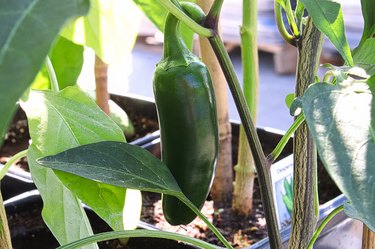
Growing jalapeno pepper plants at home can be much more cost effective in the long-term than purchasing hot peppers from the grocery store as you need them, even given the relatively inexpensive cost of fresh peppers compared to other vegetables. Hot peppers (Capsicum annuum) are also packed with seeds, providing an easy source for future generations of pepper plants after you have harvested them; that is, if you're growing heirloom peppers that come true from seed. Peppers can thrive in warm to hot climates, but if you're getting less-than-stellar results, other factors may be hampering growth.
Jalapeno Pepper Plants Germination Times
Video of the Day
Pepper seeds are notorious for their slow seed germination times. If you're starting your own jalapenos from seed indoors, it may take up to a month or longer before you will see the first sprouts from the germinated pepper seed. If you're starting the seeds in your outside soil, germination could take even longer when unique soil, climatic and atmospheric conditions are taken into account.
Video of the Day
You can encourage indoor seed germination by providing a warm environment. A seedling heating mat can encourage germination. When planting seeds directly in the ground, the soil temperature generally needs to be at least 60 degrees Fahrenheit. If it's colder, the seeds might not germinate well.
Ideal Growing Conditions
If your plants have already germinated but still aren't growing, improper soil or growing conditions could be the culprit. Jalapenos need lots of sunlight, so first ensure there is no shade or foliage blocking direct sunlight from the jalapeno plants.
Soil should be well-drained and nutrient-rich, though too high a concentration of nitrogen can have a deleterious effect on plant growth. Amend the soil as needed to create nutrient-rich soil that drains well. The ideal soil pH is between 6.2 and 7.
Adding a time-release fertilizer may improve growth. Organic compost added to the plants when first transplanted outside can also foster healthy growth. Remove any weeds growing near the jalapeno plants that could be sapping moisture away from the peppers.
Issues With Water
Despite their proclivity for warm, dry climates, jalapenos need plenty of water at all times. In very hot weather, jalapenos should be watered every other day or at the least every third day to ensure consistent soil moisture. The plants do best with at least 1 inch of water each week between rain and irrigation. Be careful not to over-water the plants as this creates a breeding ground for bacterial and fungal growth. Mulching around the jalapeno plants can help keep the soil moist.
When your jalapeno seeds are first transplanted outside after germinating indoors, they'll require more frequent watering to satisfy the young plant's moisture and nutritional needs. After the first fruiting, back off the watering to every few days if rainfall doesn't supply enough moisture.
Other Possible Causes
If you've eliminated slow germination times, poor soil conditions or moisture problems as culprits of your jalapeno's poor growth, it's possible your plant may have become infected with a disease. Insect interference from aphids, thrips and diseases like tobacco mosaic virus, root rot, cucumber mosaic virus or wilt diseases are all known to commonly affect jalapeno plants.
Carefully inspect the leaves, stems and fruit of your jalapeno plants for telltale signs of disease or pest problems, like cankers or spots on stems, wilting, yellowing or defoliating leaves, and growth on the jalapeno peppers themselves. Treatment depends on the specific cause. For some insect and disease issues, pruning the damaged parts allows the jalapeno to continue growing. Others might kill the plant, requiring you to remove it to prevent the issue from spreading to other jalapeno plants.